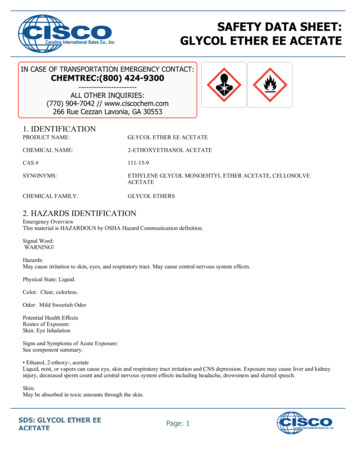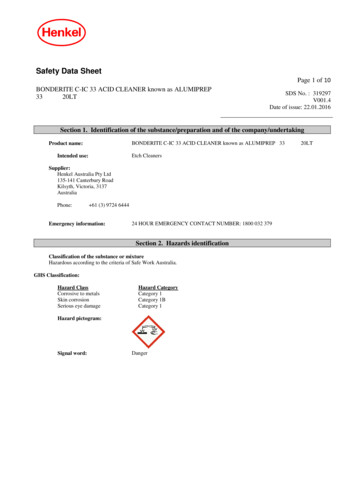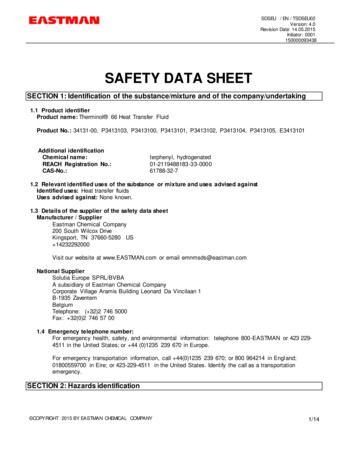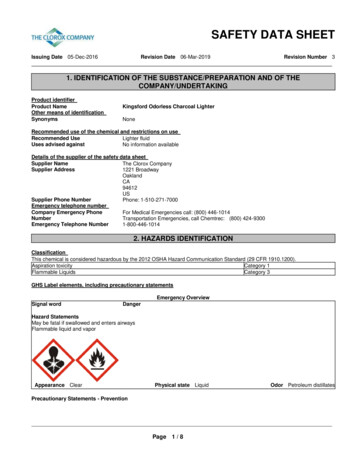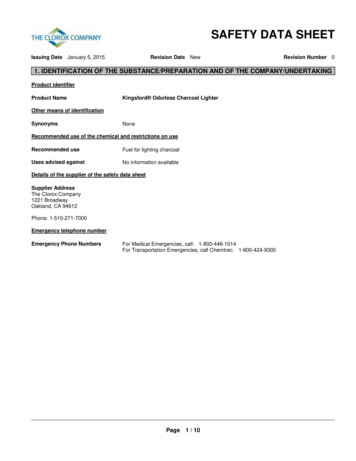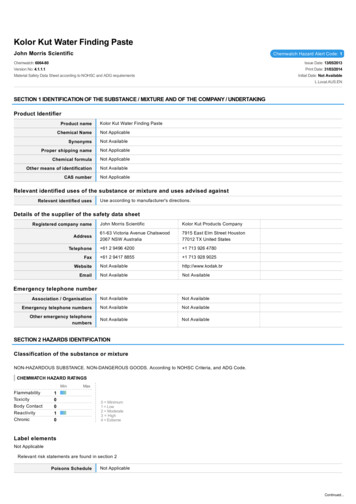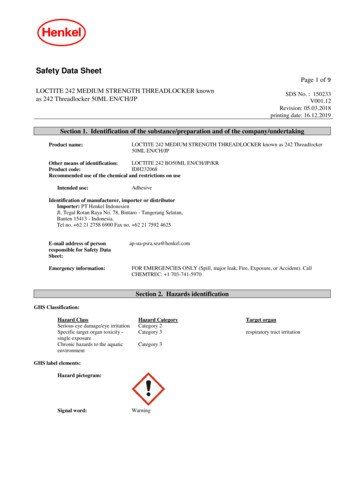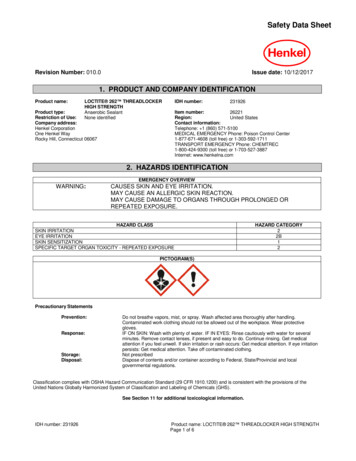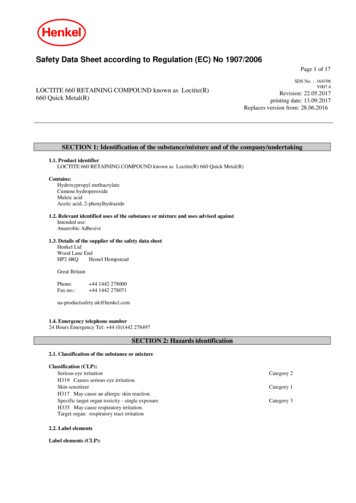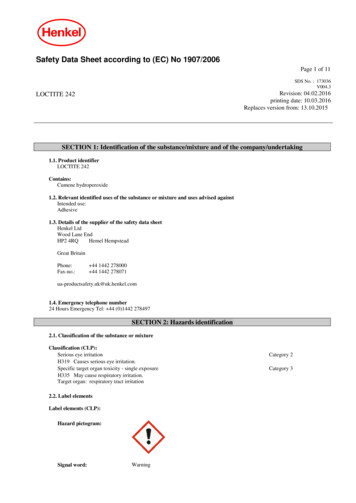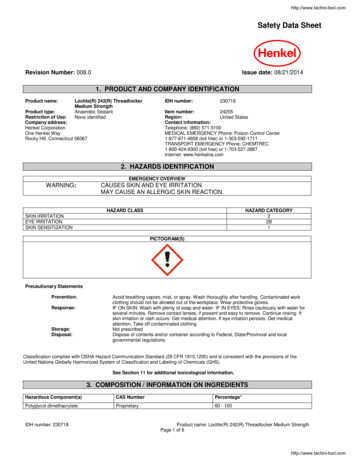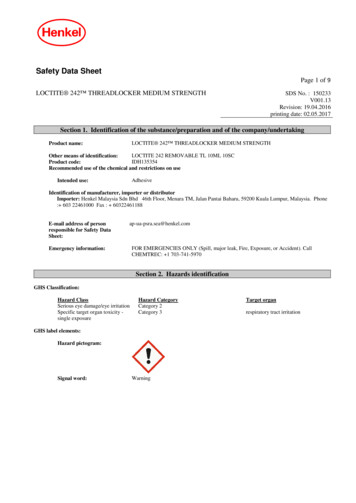
Transcription
SAFETY DATA SHEETBetco pH7Q DualSection 1. IdentificationGHS product identifier: Betco pH7Q DualProduct code: 355Product type: Liquid.Relevant identified uses of the substance or mixture and uses advised againstIdentified usesDisinfectantUses advised againstFor Industrial and Institutional Use OnlySupplier's details: Betco Corporation400 Van Camp RoadBowling Green, Ohio 43402www.betco.com888-462-3826Emergency telephonenumber (with hours ofoperation): Chemtrec (800) 424-930024 hourEPA Details: EPA Statement:This chemical is a product registered by the United States Environmental ProtectionAgency and is subject to certain labeling requirements under federal law. Theserequirements differ from the classification criteria and hazard information required forsafety data sheets (SDS), and for workplace labels of non-EPA registered chemicals.Below is the signal word as required on the label:EPA Establishment Number: 4170EPA Registration Number: 10324-141EPA Signal Word: DangerSection 2. Hazards identificationOSHA/HCS status: This material is considered hazardous by the OSHA Hazard Communication Standard(29 CFR 1910.1200).Classification of thesubstance or mixture: ACUTE TOXICITY (oral) - Category 4ACUTE TOXICITY (dermal) - Category 4SKIN CORROSION - Category 1BSERIOUS EYE DAMAGE - Category 1GHS label elementsHazard pictogramsDate of issue/Date of revision:: 2/4/2021Date of previous issue: 1/27/2021Version:51/15
Betco pH7Q DualSection 2. Hazards identificationSignal word: DangerHazard statements: Harmful if swallowed or in contact with skin.Causes severe skin burns and eye damage.Precautionary statementsPrevention: Wear protective gloves. Wear eye or face protection: Recommended: splash goggles.Wear protective clothing: Recommended: Chemical resistant gloves. Do not eat, drinkor smoke when using this product. Wash hands thoroughly after handling.Response: IF INHALED: Remove person to fresh air and keep comfortable for breathing.Immediately call a POISON CENTER or physician. IF SWALLOWED: Immediately calla POISON CENTER or physician. Rinse mouth. Do NOT induce vomiting. IF ON SKIN(or hair): Take off immediately all contaminated clothing. Rinse skin with water orshower. Wash contaminated clothing before reuse. Immediately call a POISONCENTER or physician. IF ON SKIN: Wash with plenty of soap and water. Call aPOISON CENTER or physician if you feel unwell. Take off contaminated clothing andwash it before reuse. IF IN EYES: Rinse cautiously with water for several minutes.Remove contact lenses, if present and easy to do. Continue rinsing. Immediately call aPOISON CENTER or physician.Storage: Store locked up.Disposal: Dispose of contents and container in accordance with all local, regional, national andinternational regulations.Hazards not otherwiseclassified: None known.Section 3. Composition/information on ingredientsSubstance/mixture: MixtureOther means ofidentification: Not available.Ingredient name%CAS numberdidecyldimethylammonium chlorideQuaternary ammonium compounds, benzyl-C12-16-alkyldimethyl, chloridestetrasodium ethylene diamine tetraacetateethanolAlcohols, C9-11, ethoxylated 10 - 15 10 5 3 37173-51-568424-85-164-02-864-17-568439-46-3Any concentration shown as a range is to protect confidentiality or is due to batch variation.There are no additional ingredients present which, within the current knowledge of the supplier and in theconcentrations applicable, are classified as hazardous to health or the environment and hence require reportingin this section.Occupational exposure limits, if available, are listed in Section 8.Section 4. First aid measuresDescription of necessary first aid measuresEye contactDate of issue/Date of revision: Get medical attention immediately. Call a poison center or physician. Immediately flusheyes with plenty of water, occasionally lifting the upper and lower eyelids. Check for andremove any contact lenses. Continue to rinse for at least 10 minutes. Chemical burnsmust be treated promptly by a physician.: 2/4/2021Date of previous issue: 1/27/2021Version:52/15
Betco pH7Q DualSection 4. First aid measuresInhalation: Get medical attention immediately. Call a poison center or physician. Remove victim tofresh air and keep at rest in a position comfortable for breathing. If it is suspected thatfumes are still present, the rescuer should wear an appropriate mask or self-containedbreathing apparatus. If not breathing, if breathing is irregular or if respiratory arrestoccurs, provide artificial respiration or oxygen by trained personnel. It may be dangerousto the person providing aid to give mouth-to-mouth resuscitation. If unconscious, placein recovery position and get medical attention immediately. Maintain an open airway.Loosen tight clothing such as a collar, tie, belt or waistband. In case of inhalation ofdecomposition products in a fire, symptoms may be delayed. The exposed person mayneed to be kept under medical surveillance for 48 hours.Skin contact: Get medical attention immediately. Call a poison center or physician. Wash with plentyof soap and water. Remove contaminated clothing and shoes. Wash contaminatedclothing thoroughly with water before removing it, or wear gloves. Continue to rinse for atleast 10 minutes. Chemical burns must be treated promptly by a physician. Washclothing before reuse. Clean shoes thoroughly before reuse.Ingestion: Get medical attention immediately. Call a poison center or physician. Wash out mouthwith water. Remove dentures if any. Remove victim to fresh air and keep at rest in aposition comfortable for breathing. If material has been swallowed and the exposedperson is conscious, give small quantities of water to drink. Stop if the exposed personfeels sick as vomiting may be dangerous. Do not induce vomiting unless directed to doso by medical personnel. If vomiting occurs, the head should be kept low so that vomitdoes not enter the lungs. Chemical burns must be treated promptly by a physician.Never give anything by mouth to an unconscious person. If unconscious, place inrecovery position and get medical attention immediately. Maintain an open airway.Loosen tight clothing such as a collar, tie, belt or waistband.Most important symptoms/effects, acute and delayedPotential acute health effectsEye contact: Causes serious eye damage.Inhalation: No known significant effects or critical hazards.Skin contact: Causes severe burns. Harmful in contact with skin.Ingestion: Harmful if swallowed.Over-exposure signs/symptomsEye contact: Adverse symptoms may include the following:painwateringrednessInhalation: No specific data.Skin contact: Adverse symptoms may include the following:pain or irritationrednessblistering may occurIngestion: Adverse symptoms may include the following:stomach painsIndication of immediate medical attention and special treatment needed, if necessaryNotes to physician: In case of inhalation of decomposition products in a fire, symptoms may be delayed. Theexposed person may need to be kept under medical surveillance for 48 hours.Specific treatments: No specific treatment.Date of issue/Date of revision: 2/4/2021Date of previous issue: 1/27/2021Version:53/15
Betco pH7Q DualSection 4. First aid measuresProtection of first-aiders: No action shall be taken involving any personal risk or without suitable training. If it issuspected that fumes are still present, the rescuer should wear an appropriate mask orself-contained breathing apparatus. It may be dangerous to the person providing aid togive mouth-to-mouth resuscitation. Wash contaminated clothing thoroughly with waterbefore removing it, or wear gloves.See toxicological information (Section 11)Section 5. Fire-fighting measuresExtinguishing mediaSuitable extinguishingmedia: Use an extinguishing agent suitable for the surrounding fire.Unsuitable extinguishingmedia: None known.Specific hazards arisingfrom the chemicalHazardous thermaldecomposition products: In a fire or if heated, a pressure increase will occur and the container may burst. Firewater contaminated with this material must be contained and prevented from beingdischarged to any waterway, sewer or drain.: Decomposition products may include the following materials:carbon dioxidecarbon monoxidenitrogen oxideshalogenated compoundsmetal oxide/oxidesSpecial protective actionsfor fire-fighters: Promptly isolate the scene by removing all persons from the vicinity of the incident ifthere is a fire. No action shall be taken involving any personal risk or without suitabletraining.Special protectiveequipment for fire-fighters: Fire-fighters should wear appropriate protective equipment and self-contained breathingapparatus (SCBA) with a full face-piece operated in positive pressure mode.Section 6. Accidental release measuresPersonal precautions, protective equipment and emergency proceduresFor non-emergencypersonnel: No action shall be taken involving any personal risk or without suitable training.Evacuate surrounding areas. Keep unnecessary and unprotected personnel fromentering. Do not touch or walk through spilled material. Do not breathe vapor or mist.Provide adequate ventilation. Wear appropriate respirator when ventilation is inadequate.Put on appropriate personal protective equipment.For emergency responders : If specialized clothing is required to deal with the spillage, take note of any information inSection 8 on suitable and unsuitable materials. See also the information in "For nonemergency personnel".Environmental precautions: Avoid dispersal of spilled material and runoff and contact with soil, waterways, drains andsewers. Inform the relevant authorities if the product has caused environmental pollution(sewers, waterways, soil or air). Water polluting material. May be harmful to theenvironment if released in large quantities.Methods and materials for containment and cleaning upDate of issue/Date of revision: 2/4/2021Date of previous issue: 1/27/2021Version:54/15
Betco pH7Q DualSection 6. Accidental release measuresSmall spill: Stop leak if without risk. Move containers from spill area. Dilute with water and mop upif water-soluble. Alternatively, or if water-insoluble, absorb with an inert dry material andplace in an appropriate waste disposal container. Dispose of via a licensed wastedisposal contractor.Large spill: Stop leak if without risk. Move containers from spill area. Approach release from upwind.Prevent entry into sewers, water courses, basements or confined areas. Wash spillagesinto an effluent treatment plant or proceed as follows. Contain and collect spillage withnon-combustible, absorbent material e.g. sand, earth, vermiculite or diatomaceous earthand place in container for disposal according to local regulations (see Section 13).Dispose of via a licensed waste disposal contractor. Contaminated absorbent materialmay pose the same hazard as the spilled product. Note: see Section 1 for emergencycontact information and Section 13 for waste disposal.Section 7. Handling and storagePrecautions for safe handlingProtective measures: Put on appropriate personal protective equipment (see Section 8). Do not get in eyes oron skin or clothing. Do not breathe vapor or mist. Do not ingest. Avoid release to theenvironment. If during normal use the material presents a respiratory hazard, use onlywith adequate ventilation or wear appropriate respirator. Keep in the original container oran approved alternative made from a compatible material, kept tightly closed when not inuse. Empty containers retain product residue and can be hazardous. Do not reusecontainer.Advice on generaloccupational hygiene: Eating, drinking and smoking should be prohibited in areas where this material is handled,stored and processed. Workers should wash hands and face before eating, drinking andsmoking. Remove contaminated clothing and protective equipment before enteringeating areas. See also Section 8 for additional information on hygiene measures.Conditions for safe storage,including anyincompatibilities: Store in accordance with local regulations. Store in original container protected fromdirect sunlight in a dry, cool and well-ventilated area, away from incompatible materials(see Section 10) and food and drink. Store locked up. Keep container tightly closed andsealed until ready for use. Containers that have been opened must be carefully resealedand kept upright to prevent leakage. Do not store in unlabeled containers. Useappropriate containment to avoid environmental contamination. See Section 10 forincompatible materials before handling or use.Section 8. Exposure controls/personal protectionControl parametersOccupational exposure limitsIngredient nameExposure limitsdidecyldimethylammonium chlorideQuaternary ammonium compounds, benzyl-C12-16-alkyldimethyl,chloridestetrasodium ethylene diamine tetraacetateethanolNone.None.Date of issue/Date of revision: 2/4/2021Date of previous issueNone.ACGIH TLV (United States, 3/2018).STEL: 1000 ppm 15 minutes.OSHA PEL 1989 (United States, 3/1989).TWA: 1000 ppm 8 hours.TWA: 1900 mg/m³ 8 hours.NIOSH REL (United States, 10/2016).TWA: 1000 ppm 10 hours.TWA: 1900 mg/m³ 10 hours.OSHA PEL (United States, 5/2018).TWA: 1000 ppm 8 hours.: 1/27/2021Version:55/15
Betco pH7Q DualSection 8. Exposure controls/personal protectionTWA: 1900 mg/m³ 8 hours.None.Alcohols, C9-11, ethoxylatedAppropriate engineeringcontrols: If user operations generate dust, fumes, gas, vapor or mist, use process enclosures,local exhaust ventilation or other engineering controls to keep worker exposure toairborne contaminants below any recommended or statutory limits.Environmental exposurecontrols: Emissions from ventilation or work process equipment should be checked to ensure theycomply with the requirements of environmental protection legislation. In some cases,fume scrubbers, filters or engineering modifications to the process equipment will benecessary to reduce emissions to acceptable levels.Individual protection measuresHygiene measures: Wash hands, forearms and fa
Betco pH7Q Dual Liquid. Chemtrec (800) 424-9300 24 hour SAFETY DATA SHEET GHS product identifier Product type Emergency telephone number (with hours of
